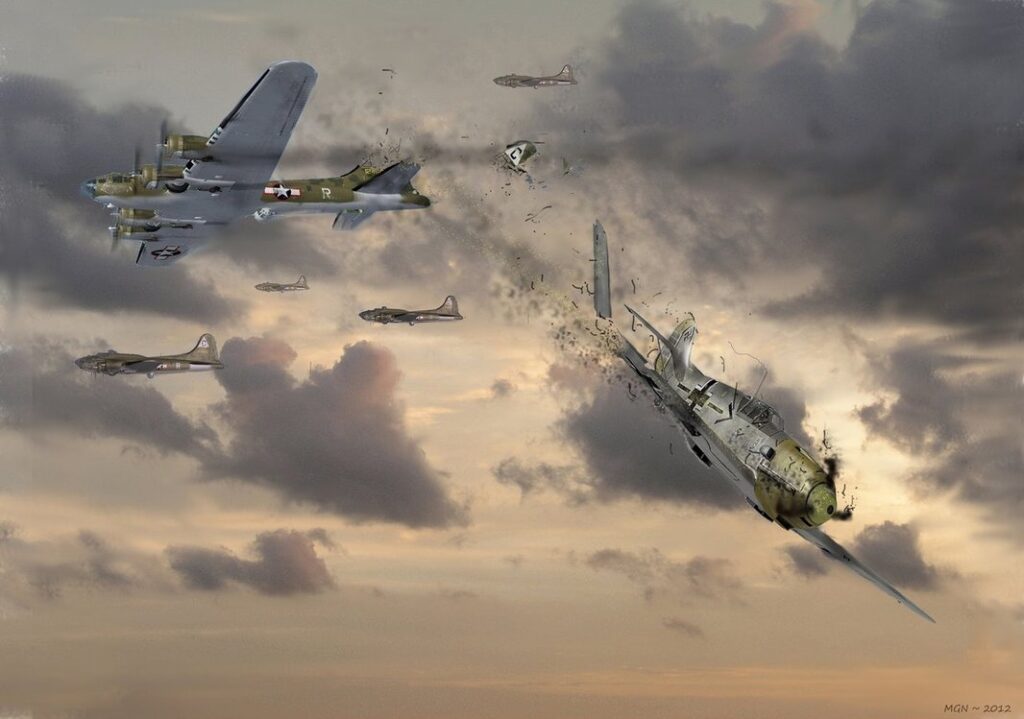

Sonderkommando “Elbe“ was the name of a World War II Luftwaffe task force assigned to bring down heavy bombers by ramming aircraft into them mid-air. The tactic aimed to cause losses sufficient to halt or at least reduce the western Allies’ bombing of Germany.
The pilots were expected to parachute out either just before or after they had collided with their target. The chances of a Sonderkommando Elbe pilot surviving such a practice were low, at a time when the Luftwaffe was lacking sufficient numbers of well-trained pilots.
This bold tactic of the Luftwaffe was created by Colonel Hans Joachim ” Hajo ” Hermann; a desperate attempt to regain control of the sky.

The aircraft of choice for this mission was the G-version (Gustav) of the Messerschmitt Bf 109, stripped of armor and armament. The heavily stripped-down planes had one synchronized machine gun (usually a single MG 131 in the upper engine cowling) instead of up to four automatic weapons (usually including a pair of 20mm or 30mm underwing-mount autocannon) on fully equipped Bf 109G interceptors, and were only allotted 60 rounds each, a normally insufficient amount for bomber-interception missions.

To accomplish their mission, Sonderkommando Elbe pilots would typically aim to ram one of three sensitive areas on the bombers: the empennage with its relatively delicate control surfaces, the engine nacelles which were connected to the highly explosive fuel system, or the cockpit itself.
The most visible and famous encounter during this attack was that of Uffz Heinrich Rosner against the lead formation of 389th Bomb Group “Sky Scorpions” (with 31 B-24 Liberators, the most produced four-engine heavy bomber of World War II).
He managed to fly his 109 through the entire formation, slice through the cockpit of the lead B-24 “Palace of Dallas” and then careen into the deputy lead B-24, taking them both out (the 389th completed its mission successfully despite this loss). Amazingly, Rosner bailed out and survived with minor injuries.
Adding to the last-ditch nature of this task force, the only mission was flown on 7 April 1945 by a sortie of 180 Bf 109s. While only 15 Allied bombers were attacked in this manner, eight were successfully destroyed.
The “Sonderkommando Elbe”, which began recruiting at the end of 1944, consisted mostly of young volunteers who had grown up under the Nazi regime and were ready to sacrifice their lives for their leaders and their country. Their use, however, remained limited. The only official use of the Sonderkommando Elbe was over the Steinhude Sea, Germany’s largest inland sea, on April 7, 1945. Most of the pilots died, but the enemy was not harmed as much as had been hoped. The attack on the bridges over the Oder yielded similarly weak results.
A manned version of the “Vengeance Weapon” V-1, the first cruise missile in military history, was never employed. The first 175 copies were built with a cockpit made for flight tests, but the Luftwaffe briefly considered using these simple bombs as suicide weapons.

This device bore a surprising similarity to the Japanese “Oka” (“Cherry Blossom”) aircraft, which was essentially a manned glide bomb. These Japanese planes, in contrast with the German ones, were used more than 70 times between March and June 1945. However, only one US destroyer was sunk while half a dozen smaller warships were badly damaged.

It is likely that the German suicide pilot missions were inspired by the Japanese example, but there is no conclusive evidence to confirm that. It is clear, however, that this murderous plan fell short of its goal: though the psychological impact of the missions was immense, the physical damage they incurred was minimal. Once the US Navy was able to recover from the initial terror of the attacks, their effect waned. Any approaching aircraft that were believed to be on kamikaze missions were shot down before they had a chance to reach their target.
Several hundred pilots who were ready to sacrifice their lives still remained in service by the time the Japanese surrendered at the end of World War II. On the day of the Armistice, their commander took his life. Yet Hajo Hermann, who led the German suicide pilots, began a new life after the war. Following a decade of prison in the Soviet Union, he became a lawyer, before dying last November at the age of 97.